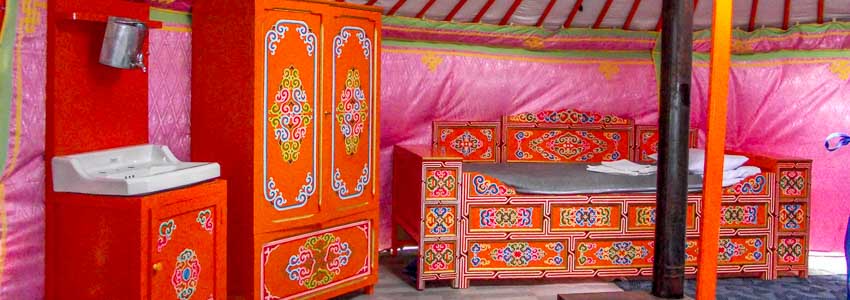Is it yurt or ger or Mongolian tent?
The correct name for the Mongolian nomadic dwelling is Ger. Yurt is a Turkic word for the Ger. Local Mongolians never say yurt, but some foreigners say. Mongolian ger is more than a tent. It is home as Mongolian nomads have been living in it throughout the year and prefer Mongol ger to other forms of housing. Mongolian ger durability, lightness and low cost are of tremendous advantage to the nomads. Below is an overall introduction to ger. The nomads' ger furnishing differs from the tourist ger camps.
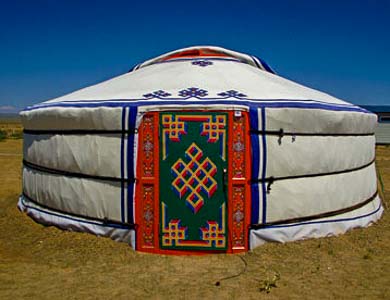
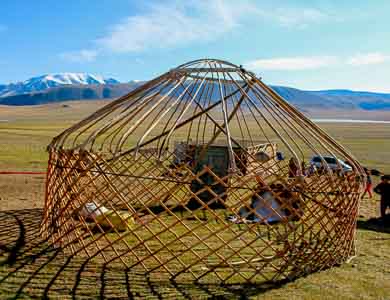
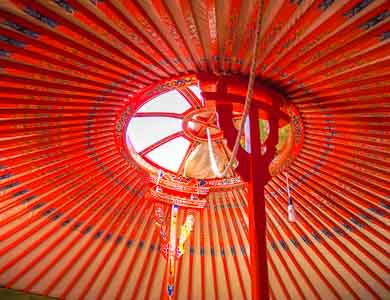
Structure of Mongolian ger / Mongolian tent
Mongolian Ger tent is a unique model of engineering - an ingenious prefabricated home. It is mostly made of wood and other locally available materials; wood, sheep wool felt, and animal hairs ropes. Quickly assembled or taken to pieces, it can easily be transported on camelback or by truck. Nowadays, Mongolians transport the gers on small tracks. The lower part of the ger consists of sections of trellis-like wood walls including the door within its framework. The upper part consists of two long upright poles supporting a central wooden roof ring, (toono), onto which many thinner poles place. Depending on the size of the ger, roof poles can number up to 108 (a sacred Buddhist number). Each one fits onto the lattice walls, fixed by straps. The roof ring is the most complex part of the ger structure. Apart from holding the poles in place and acting as a smoke vent, it is also a natural sundial. The early-morning rays indicate time for milking and pasturing animals. If it shines to the back of the ger, it is after midday and "too late" to set out on a long journey. During bad weather, the single roof "ring window" is covered with a piece of felt or canvas called Urkh. There is an unusual sequence in assembling the ger. Large items such as beds, cupboards, storage chests, and the stove, are placed out in the open air. Then the structure is assembled around them because they are too big to fit in through the door. By tradition, Mongolian gers always face south. According to ancient custom, Mongolian yurt interior has its specific place for the items. The outside wall is wrapped with felt pieces placed across the top of the ger, leaving the roof ring open for the stove's chimney, light, and air. Canvas for waterproofing covers the ger and is tied around the outer wall by three rows of ropes. In winter, extra felt layers are added. In summer the wall felt can be rolled up from ground level to let in the breeze. The Mongolian ger tent is pitched on the ground, and the floor area is covered by carpets unless the ger will stay in place for some time, in which case a wooden floor is laid.
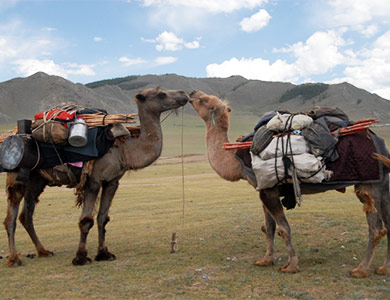
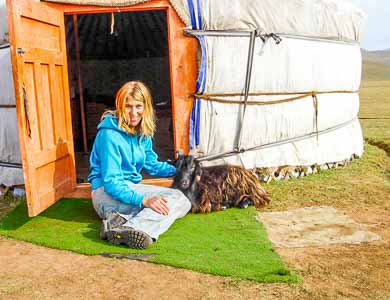
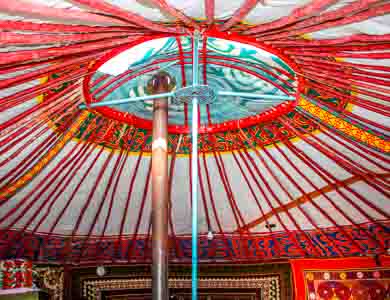
Mongolia ger size
Mongolian Gers have been a distinctive feature of life in Central Asia. There are some ancient rock drawings those prove that the ancient people used the gers/yurt about 10 thousand years ago. Nomads have been using this collapsible dwelling over the centuries. The ger suits the best to the nomadic way of life. The best use of the Mongolian ger has been since the 13th century of the Genghis Khan's Great Mongolia Empire. There were different shapes of the gers depending on the rank of the people. Mongolian ger gained today’s shape and appearance in the 16th century. There are different sizes of gers depending on the latticed wall numbers. The nomadic herders and sedentary people alike use 4-5 walls gers for their living. You will see the nomads’ main gers along with a small 3 walls gers which they use as a dairy product processing ger or a kitchen in summer, a storage area sometimes and even an area to keep weak baby animals during harsh times of springs. Mongolian nomads also use different sizes of gers depending on the region. The people in the Gobi desert use mainly 4 walls ger made of willow trees. The willow tree ger is light to carry. The Gobi people tend to move more in search of pastureland and water. The people in western Mongolia use bigger gers as they move less and have bigger families. Nowadays, the big gers of 12, 15 and 25 latticed walls are used in the tourist ger camps restaurants.
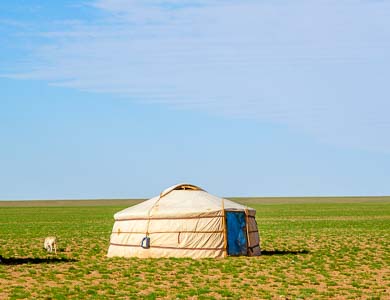
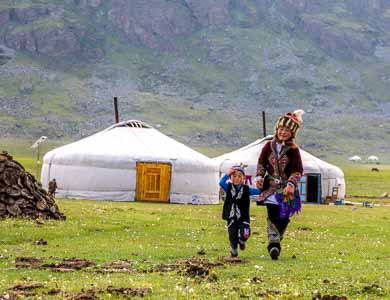
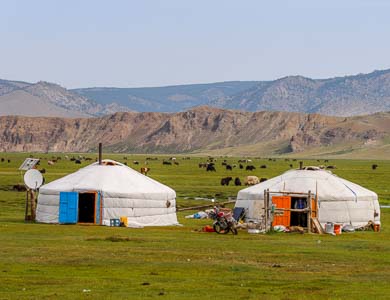
Mongolian ger interior
The north side is the place of honor. The family shrine is placed on an altar. Beds are placed close to the east and west sides stacked with colorful cushions, blankets and neatly folded bedclothes for the night. Everything is kept tidy. The west front of the ger (the man's side) keeps work equipment, such as saddle and tack, next is the calfskin sack especially for fermenting mare's milk (airbag). On the woman's side (east front) there are open shelves for jugs, pans, and bowls. As well as locate a cupboard for cooking and eating utensils. Each Mongolian ger has a stove in the middle with a ‘chimney’ poking out of the top and the fuel box next to the stove on the door side. This stove serves as a heat source and a cooking area. If they want to cool the ger down, they simply roll up the felt at the bottom and let the air blow through the bottom of the ger cooling it immediately! Whole family lives/sleep/eat inside the ger with no privacy. There is no wall or place to escape to. You will see a solar panel and satellite antenna by the gers of the nomads. The nomad can watch TV, keep meat in the fridge and charge their phone batteries.
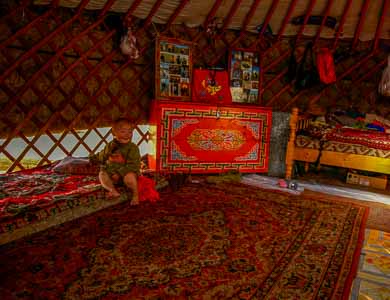
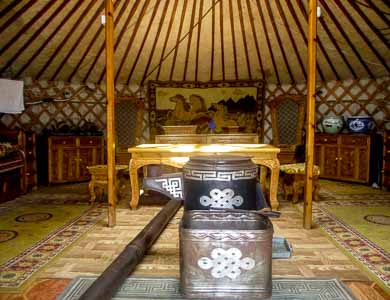
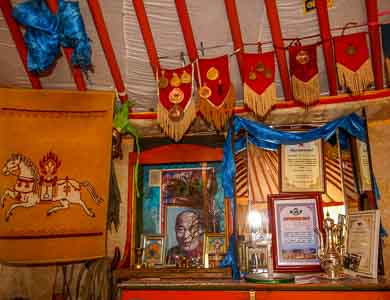
They put a sink at the ger front west door side which they use for washing hands and face. The sink is moved outside during warm seasons for sanitary.
You will find the ger wood frames are painted orange and blues. The orange color symbolizes the sun, moon, and fire while the blue is a color of the sky.
